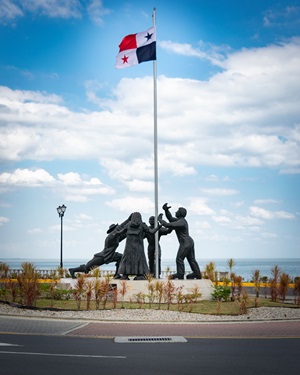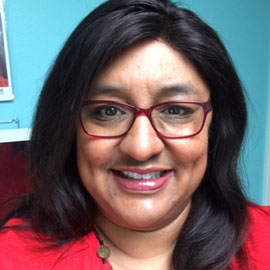Seattle Foundation Program Officer Vanesa Gutierrez speaks with a community partner about why it is important to speak with individuals about preferred identifiers, rather than seeing people groups as monoliths.
By: Vanesa Gutierrez

Seattle Foundation is committed to sharing personal reflections on identity to deepen our knowledge on backgrounds different to our own and better equip us to continue to center and expand racial equity in our work. By understanding the diversity within our multiple communities and becoming familiarized with conversations particular to each of them, there is increased learning on how to challenge racism. In this way, we acquire the power to transform ourselves and the rest of the region along with us. This blog digs into the history and conversation around terms utilized to identify members of the Hispanic, Latino/a, Latinx, Latine community.
Many have wondered and even debated the terminology used both for the name of Hispanic Heritage Month and of the over 62 million people in the United States that racially and/or ethnically identify as a member of the community. As we reflect on our shared and unique heritages and recognize the achievements of prominent figures from our collective past, it is important for individuals to have the freedom to choose how they identify while still being able to feel pride and connection with their broader ethnic and racial communities – regardless of which pan-ethnic term or identifier they want to use.
As the largest non-white racial/ethnic group in the United States, composed of people with rich and diverse heritages, it is no wonder that over time people have sought out new ways of identifying themselves to better capture their understanding and feelings about their heritage and family. It’s been interesting to see the natural evolution of these different identities in our communities and how one may identify in a variety of ways in different spaces.

In writing this blog, we had the opportunity to discuss the topic with Sandra Solano-Huber (pictured left), a member of the Community Health Board Coalition’s leadership team and Latinx Health Board member, one of our Communities of Opportunity grantees. “I always joke that I left Panama being simply Sandra Solano, arrived in Wichita, KS and was labeled “Hispanic” or “Spanish” … later moved to Los Angeles and became a “Latina” … moved to Seattle and first I was “other” … and eventually landed at Afro-Latina. So, at this point in my life, I identify as a Black Latina or an Afro-Latina.”
Hispanic as a catchall term in America came about in 1975, when the Federal Interagency Committee on Education brought together an Ad Hoc Committee on Racial and Ethnic Definitions. Through the report they developed and recommended ethnic terms for federal agencies to use for collecting data on race and ethnicity. This resulted in having Hispanic as an option for the first time on the 1980 Census, which activists hoped would result in better data showing the complex needs of their communities.
In the 2020 Census, “Hispanic or Latino (of any race)” is the option provided for those that self-identify as “Cuban, Mexican, Puerto Rican, South or Central American, or other Spanish culture or origin regardless of race.” For some, this terminology is beneficial because it brings these groups together and can make it easier for them to collectively advocate for their communities. For others, this broader terminology has also created contention and confusion, as some see the term Hispanic as centering Spanish origin, heritage, and also the colonial past, whereas Latino is thought to more specifically identify folks of Latin American origin or heritage.
“I do not use Hispanic because of its connection to colonial Spain. I have recently also learned my preference not to use Latinx, because although I appreciate the gender neutrality of the term, it fails to address the fact that it is an “Anglo” perspective, and it ignores the Spanish language and its gendered form. The term Latinx is not how we would say it in Spanish and many of our parents and grandparents refuse to use it because of that. We would be more likely to say Latine (la-tee-neh) which is more reflective of us and the most common language in Latin-America: Spanish,” Solano- Huber added.
In the late 90s, the term Latinx emerged as a more gender-inclusive option. According to a nationally representative, bilingual survey of U.S. Hispanic adults conducted in December 2019 by Pew Research Center, only 23% of U.S. adults who self-identify as Hispanic or Latino have heard of the term Latinx, and just 3% say they use it to describe themselves. While Latinx has grown in popularity in the last decade, it appears to be used less often as an identity and more as an inclusive way to describe a group or community.
More recently, Latine has started to gain popularity as an easier to pronounce option that still removes the need to use gendered language. A comic titled “You Say Latinx” by Terry Blas dives into the need for inclusive options and instead proposes the use of “e” instead of “x” in place of the “o” and “a” gendering of nouns. Only time will tell if this term will enter the common American vernacular like Hispanic or Latino have and provide new options for folks that do not want to use binary language.
Hearing the question, “What are you?” and insinuating a “What box should I put you in?” mindset routinely happens in United States according to Solano-Huber, more so than anywhere else the local leader has been. Those conversations leave Solano-Huber with “the most upsetting and even dehumanizing” feelings, so taking action to reframe the way in which identity is discussed has become a personal mission.
“The process of self-identification in my opinion has more to do with how I see myself than how others see me. And that’s empowering,” said Solano-Huber. Making sure others feel respected and valued is also a priority.
“It has been important for me to ask people how they want to be referred as, out of respect for their humanity. I personally prefer to spend my resources in supporting the needs rather than arguing which one is the most appropriate “label” to use.”
“For some of us who work directly with community in service to our needs and aspirations, the conversation is less significant against the challenges our diverse communities face including sexism. It gets ever more complex if we look at it from the equity lens, and the impact of racism in our communities.”
Sandra Solano-Huber
As more people delve more deeply into their culture and the different components of their identity, these terms will likely continue to develop, change, and expand. This is a reflection of how dynamic the community is, constantly adapting to the changing spaces and situations in which it is present. As long as we all continue on these long roads of self-discovery, being in community with one another, and gaining a deeper understanding of how we want to show up in the world, the terminology will continue to evolve.
The most important facet of this dynamic and ongoing conversation is that we are truly seeking to create and maintain space for everyone to have the ability to self-identify in a way that honors themselves, their families, their communities, and their heritage… regardless of the terminology.
To expand your knowledge on the conversation around Hispanic, Latino/a, Latinx and Latine, visit https://callmelatine.com/, a resource dedicated to addressing gender and heteronormative bias in the community.

